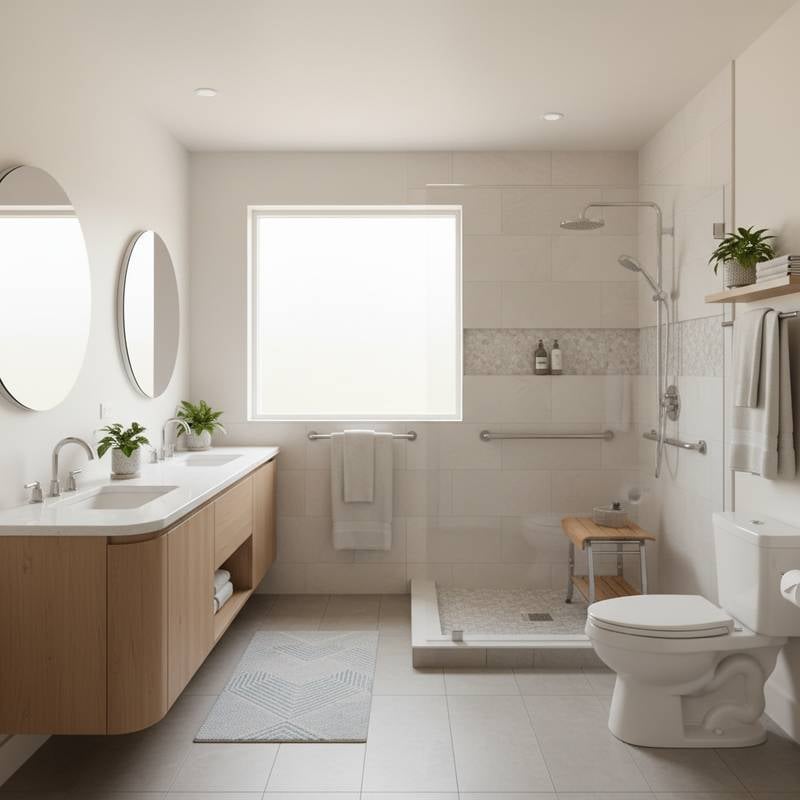Understanding Multigenerational Home Remodel Costs in 2025
Multigenerational living arrangements grow in popularity as families seek affordable housing solutions and closer connections. A full remodel to accommodate multiple generations involves creating separate yet connected living areas, often with accessibility in mind. Expect total costs to range from $150,000 to $400,000, averaging $250,000, influenced by project scale, location, and specific modifications.
Core Cost Breakdown
The price tag reflects several key elements. Square footage plays a central role; projects covering 1,000 to 2,000 square feet typically run $250 to $500 per square foot for comprehensive work. Structural adjustments, such as opening walls or reinforcing floors, add substantial expenses due to engineering needs.
Plumbing and electrical updates ensure safe, independent zones. For instance, installing a second kitchenette or full bathroom requires new lines, costing $10,000 to $30,000 each. Accessibility enhancements, including wider hallways at 36 inches minimum and non-slip flooring, contribute another layer of investment.
Project Scope Variations
Converting an existing basement or attic into a self-contained suite keeps costs lower, often under $200,000, by leveraging current infrastructure. In contrast, constructing an accessory dwelling unit (ADU) demands new foundations, roofing, and utility extensions, pushing expenses toward $300,000 or more.
Location matters significantly. Urban areas with strict codes incur higher permit fees and labor rates, while rural settings allow for more flexibility. Homeowners who prioritize energy-efficient materials, like LED lighting and insulated walls, see upfront costs rise by 10 percent but gain long-term savings.
Labor and Contractor Expenses
Professional oversight remains essential for complex remodels. A general contractor handles coordination among trades, securing permits, and adhering to timelines, comprising 20 to 35 percent of the budget. Select contractors experienced in multigenerational projects to navigate unique challenges like soundproofing between zones.
Hourly Rates for Key Trades
- Carpenters charge $70 to $120 per hour for framing and cabinetry installation.
- Electricians bill $90 to $150 per hour for wiring separate circuits and smart home integrations.
- Plumbers demand $80 to $140 per hour for fixture placements and drainage systems.
- HVAC specialists quote $7,000 to $15,000 for zoning controls that maintain comfort across living areas.
These rates vary by region; coastal cities command premiums due to demand and material transport.
Balancing Professional and DIY Efforts
Homeowners can tackle select tasks to trim expenses. Painting walls in neutral tones or installing peel-and-stick flooring saves 10 to 15 percent without compromising quality. However, avoid DIY on load-bearing modifications or gas line adjustments, as errors invite safety risks and code violations.
Professionals bring efficiency, completing phases like rough-ins in weeks rather than months. Their warranties cover workmanship, providing peace of mind for shared family spaces.
Hidden Costs and Budget Considerations
Permits, Designs, and Planning
Local authorities require permits for any alteration affecting structure or utilities, adding $3,000 to $10,000. Engage an architect for custom plans, especially for ADUs, at $5,000 to $20,000. These documents ensure compliance and facilitate financing approvals.
Material Selections
Choices in finishes drive 30 to 40 percent of costs. Opt for durable quartz surfaces over granite for kitchens shared by all ages, budgeting $35,000 to $70,000 for primary areas. Laminate alternatives mimic high-end looks at half the price, ideal for high-traffic zones.
Accessibility Integrations
Incorporate universal design from the start. Zero-step entries and adjustable counter heights cost $10,000 to $30,000 but enhance usability for children, adults, and seniors. Features like motion-sensor lights reduce energy use while supporting varying mobility levels.
Strategies to Control Expenses
- Maximize existing layouts by reconfiguring rooms rather than expanding outward. This approach cuts foundation work and maintains the home's footprint.
- Cluster wet areas, such as bathrooms near kitchens, to minimize plumbing runs and save $5,000 to $15,000.
- Select versatile, mid-tier materials that withstand daily wear, like vinyl plank flooring resistant to spills.
- Implement changes in stages: Focus on essentials like bedrooms first, then add luxuries as funds allow.
- Partner with a design-build firm to streamline processes, avoiding markups from separate consultants.
These tactics preserve quality while aligning with financial realities.
Evaluating Return on Investment
Investments in multigenerational features yield tangible benefits. Flexible designs attract diverse buyers, boosting resale values by 10 to 20 percent in family-oriented markets. ADUs offer rental potential, generating $1,500 monthly income in many areas.
Energy upgrades, including solar-ready roofing and efficient appliances, recoup 60 to 80 percent through utility savings and appraisals. Prioritize layouts with private entrances and communal gathering spots to maximize appeal.
When to Choose DIY or Professionals
Suitable DIY Projects
Cosmetic enhancements suit hands-on owners. Refresh cabinet hardware or add shelving in common areas using basic tools. These efforts personalize spaces and build skills for minor upkeep.
Essential Professional Interventions
Entrust structural, electrical, and plumbing tasks to experts. They ensure seamless integration, such as hidden wiring for home offices or theaters. Speed and precision prevent disruptions in occupied homes.
Data Sources for Cost Estimates
Estimates draw from contractor bids, industry surveys, and regional data across U.S. markets. Midrange scenarios assume standard labor and materials; adjust upward for custom elements or downward for basic conversions.
Common Questions
What budget should I set for a multigenerational remodel? Projects span $150,000 to $400,000, scaled to home size and additions.
Does converting space cost less than building an ADU? Yes, repurposing areas avoids new construction expenses like site preparation.
Are permits always necessary? Structural or system changes demand them for legal and safety reasons.
How long do these remodels last? Timelines range from three to six months, based on complexity and crew size.
Will this increase my home's value? Adaptable features often elevate prices by 10 to 20 percent.
Sustaining Your Remodeled Home
Regular upkeep extends the lifespan of investments. Inspect shared systems annually, addressing leaks or filter changes promptly. Encourage routines like deep cleaning to maintain hygiene in high-use areas.
Over time, revisit designs to adapt to evolving needs, such as tech integrations for remote monitoring. This forward-thinking approach ensures the space remains a supportive hub for generations.











